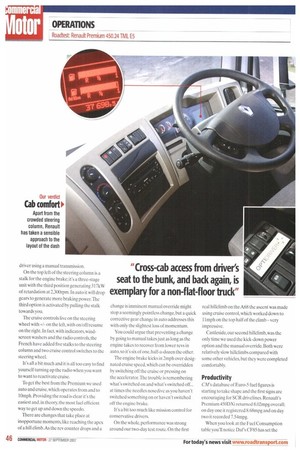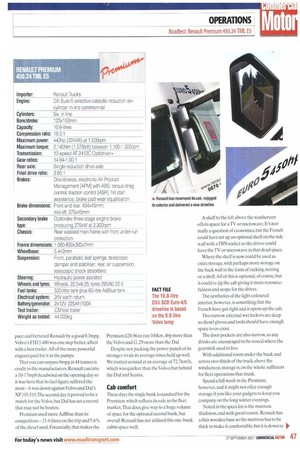CHANGING PERCEPTIONS
Page 45

Page 46

Page 47

Page 48

If you've noticed an error in this article please click here to report it so we can fix it.
The Renault Premium has had to overcome a poor reputation and a perception that it didn't offer good value for money. But a revamped cab and fresh driveline have put it back among the front runners.
Renault Trucks, like its contemporaries, has been busy tweaking its vehicles' specifications to provide state-of-theart products to operators. In the Premium's case this evolution has included an automated transmission.This will be welcomed by operators keen to deal with less competent drivers, especially in the larger fleets. The Premium. unlike most of its competitors, suffered from poor market perception in its early days, not least because of its no-frills cab. Its saving graces were the 385hp and 420DCi engines and value for money. In fact, most open-minded drivers begrudgingly enjoyed the Premium experience once they'd been coaxed behind the wheel with a pasty.
It was undervalued from its inception by Renault. being designed to get a leg up in the market with buy-hacks, This worked to a degree, hut operators closely associate quality with its price tag; never in British industry does one get owt for nowt'.
The current 10.8-litre DX111 SCR Euro-4/5 driveline.which has the potential to rival the 385 and 420, broke cover in April 2006. It's based on the 9.0-litre Volvo lump.
Renault offers three power ratings: 370hp/1,735Nm; 410hp/1 ,900Nm; and (as tested here), 450hp/2,140Nm.The soon-tobe-tested Magnum has the DXi13 engine rated at 460 and 500hp.
The long-distance option comes in several guises; twoor three-axle rigid; 4x2 tractor unit; and 6x2 (pusher axle) tractor unit. Cabs come in sleeper and day cab guise, with standard or high roofs and three levels of linish:Allia nce, Privilege and Excellence. For this test we had to settle for Privilege.
Renault offers seven transmissions (five manuals and two autos) from the Super H (four-over-four replacing the slap-over) to Opticiriver+, as fitted here, which is born from Volvo's I-Shift. Drive axles come with single and double reduction, and there are four fifth-wheel heights.
A Premium 450-24 TML Euro-5 chassiscab is listed at £83,310. On top of this Euro-5 compliance will set you back £1,760 (though this is reclaimed through the VED incentives over four years); Optidriver+ with Optibrake is £3,904; the Privilege cab is €2,800; and the reversing buzzer is £42. On the road Two pedals good; three pedals had.That seems to he the way of things at the moment with manufacturers introducing automated transmissions quicker than some operators seem to want.
The benefits of autos are twofold: reducing the chance of driver error and prolonging the life of the clutch.The only perceived disadvantage is that some drivers feel the job is becoming de-skilled.
Let's concentrate on the benefits.The auto box is operated from a stalk located on the steering column. It has a D and N switch denoting drive and neutral, with a C for crawl and R for reverse towards the end of the column. Lift up the stalk and it switches between auto and manual.
So, fire up the engine, put it in D and away you go. Pressure on the accelerator will tell the transmission when to change, generally somewhere between 1,400 and 1,500rpm depending on the gradient. It also likes to lug down before changing,just like a decent driver using a manual transmission.
On the top left of the steering column is a stalk for the engine brake; it's a three-stage unit with the third position generating 317kVv' of retardation at 2,300rpm. In auto it will drop gears to generate more braking power.The third option is activated by pulling the stalk towards you.
The cruise controls live on the steering wheel with +/on the left, with on/off/resume on the right. In fact, with indicators, windscreen washers and the radio controls, the French have added five stalks to the steering column and two cruise control switches to the steering wheel.
It's all a bit much and it is all too easy to find yourself turning up the radio when you want to want to reactivate cruise.
To get the best from the Premium we used auto and cruise, which operates from and to lOmph. Providing the road is clear it's the easiest and. in theory, the most fuel efficient way to get up and down the speedo.
There are changes that take place at inopportune moments, like reaching the apex of a hill climb, As the rev counter drops and a change is imminent manual override might stop a seemingly pointless change, but a quick corrective gear change in auto addresses this with only the slightest loss of momentum.
You could argue that preventing a change by going to manual takes just as long as the engine takes to recover from lower revs in auto, so it's six of one, half-a-dozen the other.
The engine brake kicks in 2mph over designated cruise speed, which can be overridden by switching off the cruise or pressing on the accelerator.The trouble is remembering what's switched on and what's switched off... at times the needles nosedive as you haven't switched something on or haven't switched off the engine brake.
It's a bit too much like mission control for conservative drivers.
On the whole, performance was strong around our two-day test route. On the first real hillclimb on the A68 the ascent was made using cruise control, which worked down to I lmph on the top half of the climb— very impressive.
Castleside, our second hillclimb,was the only time we used the kick-down power option and the manual override. Both were relatively slow hillclimbs compared with some other vehicles, but they were completed comfortably.
Produdivity
CM's database of Euro-5 fuel figures is starting to take shape and the first signs are encouraging for SCR drivelines. Renault's Premium 450DXi returned 8.02mpg overall; on day one it registered 8.68mpg and on day two it recorded 7.54mpg.
When you look at the Fuel Consumption table you'll notice Dafs CF85 has set the pace and bettered Renault by a good 0.3mpg. Volvo's FH13.480 was one step better, albeit with a box trailer. All of the more powerful engines paid for it at the pumps.
That you can surpass 8mpg at 44 tonnes is credit to the manufacturers. Renault ran into a 10-17mph headwind on the opening day so it was here that its fuel figure suffered the most — it was down against Volvo and Des XF105.510.The second day it proved to be a match for the Volvo, but Daf has set a record that may not be beaten.
Premium used more AdBlue than its competitors — 15.4-litres on the trip and 5.6% of the diesel used. Financially, that makes the Premium £28.96 to run 100km, 46p more than the Volvo and £1.29 more than the Daf.
Despite not packing the power punch of its stronger rivals its average times held up well. We trotted around at an average of 72.7km/h, which was quicker than the Volvo, but behind the Daf and Scania.
Cab comfort
These days the single bunk is standard for the Premium, which reflects its role in the fleet market.That does give way to a huge volume of space for the optional second bunk, but overall Renault has not utilised this one-bunk cabin space well. A shelf to the left above the windscreen offers space for a TV or microwave. It's normally a question of economics, but the French could have set up an optional shelf on the side wall with a DIN socket so the driver could have the TV or microwave in that dead space.
Where the shelf is now could be used as extra storage, with perhaps more storage on the back wall in the form of racking,netting or a shelf.Allof this is optional, of course, but it could re-jig the cab giving it more resourcefulness and scope for the driver.
The aesthetics of the light-coloured interior, however, is something that the French have got right and it opens up the cab.
Two narrow external wet lockers are deep so diesel gloves and tools should have enough space to co-exist.
The door pockets are also narrow, so any drinks arc encouraged to be stored where the gearstick used to live.
With additional room under the bunk and across two-thirds of the truck above the windscreen, storage is, on the whole, sufficient for fleet operations that trunk.
Spend a full week in the Premium, however, and it might not offer enough storage if you like your gadgets to keep you company on the long winter evenings.
Noted in the specs list is the mattress thickness, and with good reason. Renault has a thin wooden base so the mattress has to be thick to make it comfortable, but it is down to each driver's personal preference.
The passenger seat in the Privilege cab of the Premium folds down to provide more space, but as we have mentioned before, the French used to offer a solo cab option.With more than 90% of the industry running solo this has to he considered for a return. You can always fit a fold-away seat with a safety belt in case a passenger joins.
There are plenty of internal lights, with the main two above the driver's door and the one situated at the head of the bunk behind the passenger's seat.
This truck also came fitted with an air line enabling the driver to use a variety of additional equipment to clean the cab, but otherwise it's option free.
Apart from the already mentioned crowded steering column, Renault has taken a sensible approach around the dash. Everything is within reach of even the shortest-armed driver on the company's books.
You can pull up most details on the dash, including fuel consumption in the form of lit/100km and mpg to keep the weight off the accelerator as you go. And as for the driver's seat, it's flexible and comfortable.
The lack of a gearstick is a main plus. It's hard to imagine automated transmissions having an effect on a night's sleep.
Cross-cab access from driver's seat to the bunk — and back again— is exemplary for a non-flat-floor truck. •


























































































































































































